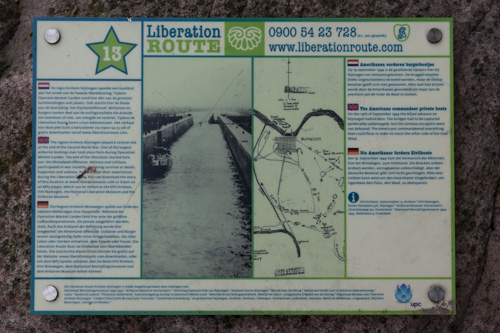Liberation Route Marker 013
Liberation Route Europe is a certified Cultural Route of the Council of Europe. With hundreds of sites and stories in nine European countries, the route links the main regions along the advance of the Allied Forces in 1943-1945.
The entire route consists of themed routes that can be travelled by by hiking, walking, cycling and car. These routes pass numerous historical and interesting sites and tell stories from a multitude of perspectives that were important in the final phase of World War II.
Many routes feature listening spots, offering the opportunity to listen to a historical story at a location. In addition, many ‘Vectors of Memory’ have been placed, indicating that the passer-by is on one of the Liberation Routes.
The routes can be found on the Liberation Route Europe website or in the app through which many stories can also be listened to.
The Americans commandeer private boats
On the 19th of September 1944 the Allied advance on Nijmegen halted here. The bridges had to be captured (preferably undamaged), but the German occupiers were not defeated. The Americans commandeered everything that could float in order to reach the other side of the River Waal.
Inland shipping is these days an important element in the Dutch transport sector. The Waal is itself one of the busiest rivers for navigation. However, during the Second World War there were no Dutch barges or container ships sailing here, but just rowing boats carrying soldiers.
As a precaution, the Germans had laid explosive charges on the road and rail bridges in September of 1944. The Germans held the bridges, and thought the Allies would be unable to cross the river Waal.
On September 19 1944, heavy fighting took place between American and German troops, south of the road and rail bridges. The next day, September 20th, began one of the most celebrated and heroic river crossings of the war.
Audiospot - The Americans commandeer private boats
Do you have more information about this location? Inform us!
Source
- Text: TracesOfWar & Liberationroute.com
- Photos: Arjan Vrieze
Nearby
Museum
Point of interest
- Information Sign Weurtsche Gat - Weurt
- Remains Church Building of the Carmelite Monastery Nijmegen - Nijmegen
- White Stripe Nijmegen - Nijmegen
Monument
- War Memorial H. Andrew's Church - Weurt
- Liberation Route Marker 017 - Nijmegen
- Memorial Waal River Crossing - Lent (Nijmegen Noord)
Cemetery
- Commonwealth War Graves General Cemetery Slijk-Ewijk - Slijk-Ewijk
- Dutch War Grave Nijmegen - Nijmegen
- Commonwealth War Cemetery Jonkerbos - Nijmegen
Remembrance Stone
- Remembrance Stone Jan van Hoof - Nijmegen
- Stumbling Stones Begijnenstraat 11 - Nijmegen
- Stumbling Stones Stikke Hezelstraat 54 (formerly 46) - Nijmegen






